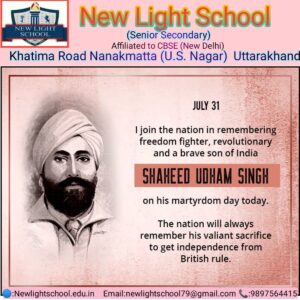Shaheed Udham Singh Martyrdom Day 31 July
On 31 July 1940, Singh was hanged at Pentonville Prison by Albert Pierrepoint. His remains are preserved at the Jallianwala Bagh in Amritsar, Punjab. On every 31 July, marches are held in Sunam (Singh’s hometown) by various organisations and every statue of Singh in the city is paid tribute with flower garlands.
Based on the life of Udham Singh, who assassinated Michael O’Dwyer in London to avenge the 1919 Jallianwala Bagh massacre in Amritsar, the film starred Vicky Kaushal in the title role, along with Shaun Scott, Stephen Hogan, Amol Parashar, Banita Sandhu and Kirsty Averton in supporting roles.
Early Life of Udham Singh
Udham Singh born as Sher Singh on 26th December 1899 at Sunam, Sangrur district of Punjab. His father, Sardar Tehal Singh Jammu, was a farmer in the village of Upali.
Upon the death of his father, he was taken in by the Central Khalsa Orphanage in Amritsar. He was named as Udham Singh following Sikh rites. He left the orphanage in 1919 after passing his matriculation examination in 1918.
Jallianwala Bagh Massacre
On 13th April 1919, about 20,000 unarmed people were gathered in Jallianwala Bagh, Amritsar, to protest against the arrests and heavy handed-police crackdown that came about with the passing of the Rowlatt Act. They were surrounded by British troops under the command of General Reginald Dyer
The protestors were fired upon by the British soldiers, causing casualties upwards of 1000 deaths and injuring more than 1500. The massacre would forever change the course of the Indian Independence Struggle.
The massacre also had a profound effect on Udham Singh who at that point became actively involved in revolutionary activities and politics. He was deeply influenced by Bhagat Singh his group. Udham Singh joined the Ghadar Party in 1924 to organise overseas Indians with the purpose of overthrowing colonial rule. In 1927, while returning to India with associates and weapons to carry out revolutionary activities, he was arrested for illegal possession of firearms and sentenced to five years in prison.
After his release from prison in 1931, Udham Singh evaded police surveillance, who was watching him due to his association with the Ghadar Party. He made his way to Germany and reached London in 1934. Finding employment in the city, he made plans to assassinate Michael O’Dwyer for his part in the massacre at Jallianwala Bagh.
To know more about the difference between the moderate and extremist phase of the Indian Independence movement, visit the linked article.
The assassination of Michael O’Dwyer
On March 13, 1940, Michael O’Dwyer was scheduled to speak at Caxton Hall in London. Concealing a revolver he had purchased, Udham Singh found an open seat in the hall and waited for Michael O’Dwyer to arrive. As Michael was making his way to the speaking platform, Udham Singh shot at him twice. The bullets pierced Michael’s vital organs, killing him instantly. Udham Singh surrendered after the shooting.

Trial and Execution of Udham Singh
Udham Singh was charged for the assassination of Michael O’Dwyer He remained in imprisoned at Brixton Prison throughout his trial. While in custody he used the name Ram Mohammad Singh Azad to represent the three major religions of the Punjab region and his anti-colonial sentiments.
His trial began on 4th June 1940 at the Central Criminal Court, Old bailey. He was defended by VK Krishna Menon and St. John Hutchinson, while the prosecution was represented by G.B. Mc Clure. When asked about the motive behind the assassination he is reported to have said that he “was seeking vengeance for the crushing the spirit of his people”
Udham Singh was convicted of murder and sentenced to death. On July 31st, 1940 he was hanged and buried at Pentonville Prison.
His remains were exhumed and repatriated at the request of the government of India in 1974. The casket which contained his remains were where the casket was received by Indira Gandhi and other important members of the Indian government. Udham Singh was later cremated in his birthplace of Sunam in Punjab and his ashes were scattered in the Sutlej river. Some of his ashes were retained. They are currently kept inside a sealed urn at Jallianwala Bagh.

